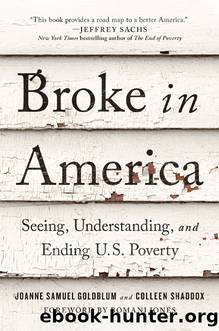Broke in America: Seeing, Understanding, and Ending US Poverty by Joanne Samuel Goldblum & Colleen Shaddox

Author:Joanne Samuel Goldblum & Colleen Shaddox [Goldblum, Joanne Samuel & Shaddox, Colleen]
Language: eng
Format: epub
Tags: Social Science, sociology, General, history, United States, 21st Century, Social Classes & Economic Disparity
ISBN: 9781950665631
Google: mnjnDwAAQBAJ
Publisher: BenBella Books
Published: 2021-02-02T23:20:34.994952+00:00
CHAPTER 10
Sexism
Womenâs Work
Work is frequently prescribed as the way out of poverty. Yet most US adults living in poverty are employed. When we started writing this book, the unemployment rate was 3.7 percent. But people ages eighteen to sixty-four fell below the federal poverty guidelines at three times that rate. Certified nursing assistants like Chicagoâs Shatonia Jackson and Petra Salas work more than most US Americans. Salas calculated that she is on the job fifty-six hours in an average week and commutes an hour by bus each way. Jackson described herself as âworn out, exhausted, overwhelmed, burnt out.â She added, âBut I still have to get up and do it every single day.â
Not every job puts food on the table, especially if you are doing âwomenâs work.â Women in the United States are 36 percent more likely to be in poverty than men and are more likely to live in extreme poverty, defined as subsisting on an income at or below 50 percent of the federal poverty guidelines.1 While women of all races and ethnicities are more likely to be poor than men, the poverty rate is even higher among women who are black, Native American, Hispanic, or Asian.
There are many ways in which sexism compromises career and financial opportunities for womenâtoo many for us to examine here. We will look at economic sexism through a single lens: the concentration of women in low-wage jobs. An analysis by the Institute for Womenâs Policy Research compared occupations where most workers are female with those where most workers are male. At every skill level, male-dominated occupations paid higher wages. The analysis also found that the occupations where women were breaking into traditionally male fields tended to be those requiring a college degree. In fields open to women with less education, gender segregation is nearly as stark today as it was in the 1960s.2
Women make up 93.8 percent of childcare workers, who are paid a median hourly wage of $11.65, according to the Bureau of Labor Statistics (BLS). Earning even less are restaurant waitstaff, at $11.00 per hour, with women making up 71.3 percent of the profession. Women are 89 percent of maids and housecleaners, with median weekly earnings of $490. Today only 30 percent of fast-food workers are teenagers, and 56.5 percent of fast-food workers over age twenty are women.3 In other words, more of those low-wage jobs are held by people who are supporting themselves and even supporting families.
Nursing assistants like Jackson and Salas are in middle-skill occupations, jobs that require some training after high school but not a college degree. More than 89 percent of home health aides and nursing assistants are women, according to the BLS. A nursing assistant made a median hourly rate of $14.25 in 2019. Compare that with wages in the building trades, also generally middle-skill jobs. A carpenterâs median wage for the same period was $23.24. Only 2.8 percent of carpenters are women, with the other building trades routinely coming in with single-digit representation for women.
Download
This site does not store any files on its server. We only index and link to content provided by other sites. Please contact the content providers to delete copyright contents if any and email us, we'll remove relevant links or contents immediately.
| Africa | Americas |
| Arctic & Antarctica | Asia |
| Australia & Oceania | Europe |
| Middle East | Russia |
| United States | World |
| Ancient Civilizations | Military |
| Historical Study & Educational Resources |
Machine Learning at Scale with H2O by Gregory Keys | David Whiting(4190)
Never by Ken Follett(3796)
Fairy Tale by Stephen King(3220)
The Man Who Died Twice by Richard Osman(2997)
Oathbringer (The Stormlight Archive, Book 3) by Brandon Sanderson(2890)
Will by Will Smith(2794)
Rationality by Steven Pinker(2291)
The Dark Hours by Michael Connelly(2246)
Can't Hurt Me: Master Your Mind and Defy the Odds - Clean Edition by David Goggins(2229)
Friends, Lovers, and the Big Terrible Thing by Matthew Perry(2123)
The Dawn of Everything: A New History of Humanity by David Graeber & David Wengrow(2122)
Principles for Dealing With the Changing World Order: Why Nations Succeed and Fail by Ray Dalio(1974)
HBR's 10 Must Reads 2022 by Harvard Business Review(1778)
A Short History of War by Jeremy Black(1763)
Go Tell the Bees That I Am Gone by Diana Gabaldon(1687)
515945210 by Unknown(1601)
A Game of Thrones (The Illustrated Edition) by George R. R. Martin(1591)
Kingdom of Ash by Maas Sarah J(1529)
443319537 by Unknown(1470)
